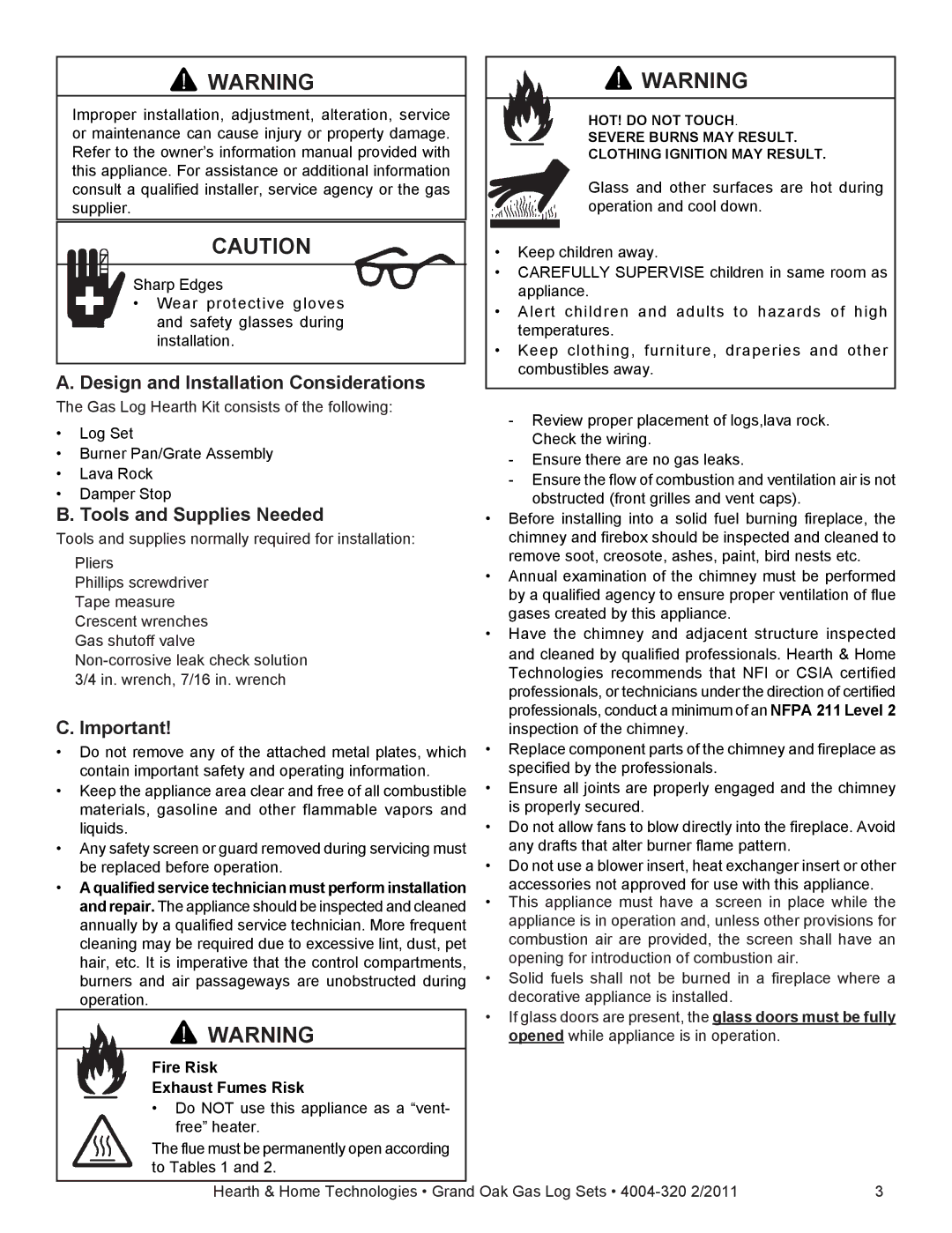
![]() WARNING
WARNING
Improper installation, adjustment, alteration, service or maintenance can cause injury or property damage. Refer to the owner’s information manual provided with this appliance. For assistance or additional information consult a qualified installer, service agency or the gas supplier.
CAUTION
Sharp Edges
•Wear protective gloves and safety glasses during installation.
A.Design and Installation Considerations
![]() WARNING
WARNING
HOT! DO NOT TOUCH.
SEVERE BURNS MAY RESULT.
CLOTHING IGNITION MAY RESULT.
Glass and other surfaces are hot during operation and cool down.
•Keep children away.
•CAREFULLY SUPERVISE children in same room as appliance.
•Alert children and adults to hazards of high temperatures.
•Keep clothing, furniture, draperies and other combustibles away.
The Gas Log Hearth Kit consists of the following: | - Review proper placement of logs,lava rock. | |||
• | Log Set | |||
Check the wiring. | ||||
• | Burner Pan/Grate Assembly | |||
- Ensure there are no gas leaks. | ||||
• | Lava Rock | |||
- Ensure the flow of combustion and ventilation air is not | ||||
• | Damper Stop | |||
obstructed (front grilles and vent caps). | ||||
B. Tools and Supplies Needed | • Before installing into a solid fuel burning fireplace, the | |||
Tools and supplies normally required for installation: | chimney and firebox should be inspected and cleaned to | |||
| Pliers | remove soot, creosote, ashes, paint, bird nests etc. | ||
| • Annual examination of the chimney must be performed | |||
| Phillips screwdriver | |||
| by a qualified agency to ensure proper ventilation of flue | |||
| Tape measure | |||
| gases created by this appliance. | |||
| Crescent wrenches | |||
| • Have the chimney and adjacent structure inspected | |||
| Gas shutoff valve | |||
| and cleaned by qualified professionals. Hearth & Home | |||
| ||||
| Technologies recommends that NFI or CSIA certified | |||
| 3/4 in. wrench, 7/16 in. wrench | |||
| professionals, or technicians under the direction of certified | |||
|
|
| ||
C. Important! | professionals, conduct a minimum of an NFPA 211 Level 2 | |||
inspection of the chimney. | ||||
• Do not remove any of the attached metal plates, which | • Replace component parts of the chimney and fireplace as | |||
| contain important safety and operating information. | specified by the professionals. | ||
• Keep the appliance area clear and free of all combustible | • Ensure all joints are properly engaged and the chimney | |||
| materials, gasoline and other flammable vapors and | is properly secured. | ||
| liquids. | • Do not allow fans to blow directly into the fireplace. Avoid | ||
• Any safety screen or guard removed during servicing must | any drafts that alter burner flame pattern. | |||
| be replaced before operation. | • Do not use a blower insert, heat exchanger insert or other | ||
• A qualified service technician must perform installation | accessories not approved for use with this appliance. | |||
| and repair. The appliance should be inspected and cleaned | • This appliance must have a screen in place while the | ||
| annually by a qualified service technician. More frequent | appliance is in operation and, unless other provisions for | ||
| cleaning may be required due to excessive lint, dust, pet | combustion air are provided, the screen shall have an | ||
| hair, etc. It is imperative that the control compartments, | opening for introduction of combustion air. | ||
| burners and air passageways are unobstructed during | • Solid fuels shall not be burned in a fireplace where a | ||
| operation. |
| decorative appliance is installed. | |
| WARNING | • If glass doors are present, the glass doors must be fully | ||
| opened while appliance is in operation. | |||
Fire Risk
Exhaust Fumes Risk
•Do NOT use this appliance as a “vent- free” heater.
The flue must be permanently open according to Tables 1 and 2.
Hearth & Home Technologies • Grand Oak Gas Log Sets •
